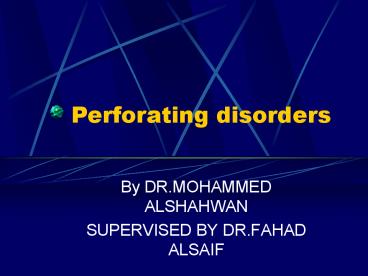Perforating disorders - PowerPoint PPT Presentation
1 / 23
Title:
Perforating disorders
Description:
IN 1982 White&Hurwitz described reactive perforating collagenosis ... Genosyndroms e.g.Downs,osteogenesis imperfecta,Marfans,EDS,cutis laxa, ... – PowerPoint PPT presentation
Number of Views:1155
Avg rating:3.0/5.0
Title: Perforating disorders
1
Perforating disorders
- By DR.MOHAMMED ALSHAHWAN
- SUPERVISED BY DR.FAHAD ALSAIF
2
- DEFINITION
- A group of conditions characterized by
- Transepithelial elimination of dermal
- Substance pathologically umbilicated
- Papules w central white keratotic crusts
- Clinically
3
- IN 1916 Kyrle described (hyperkeratosis
- follicularis et parafollicularis in cutem
penetrans) - IN 1968 MehreganCoskey described
- Perforating folliculitis
- IN 1982 WhiteHurwitz described reactive
perforating collagenosis
4
- Rapini colleagues delineated this disorder as
acquired perforating dermatosis. - Miescher described (ELASTOSIS PERFORANS
SERPIGINOSA)
5
- 1.KYRLE DISEASE
- Etiology
- AR
- pathogenic event is uncoupling of
- epithelial proliferationdifferentiation
6
- Pathology
- early lesions
- Focal parakeratosis,acanthosiscells of
- The basal layer increase in number and
- Disorganized.
- late lesions
- Follicular infundibulum/acrosyringium
- Dilated w funnel-shaped horny plug.
7
- Advancing parakeratotic column perforate
- The BMZ(at opening of sebaceous gland
- Ductthe pit of acrosyringium)
- before perforation---mononuclear cell
- after perforation---PMNC--granuloma--scar
- perifollicular epidermis
- pefroration is not must for diagnosis and occur
less common in kyrle disease
8
- Clinical features
- chronic difficult to treat
- In 3rd-5th decades more in female
- Asymptomatic or slightly pruritic
- not associated w systemic disease
- can involve extensors,scapular area,hands,feet
and perianal-perigenital areas - different stages of lesions leaving atrophic
scar - And patchy hypo/hyperpigmentation
9
- Treatment
- NO specific Tx
- topical keratolytics/retinoids
- tissue-destructive modalities e.g.
cryotherapy,CO2 laser. - oral retinoids very effective alone or w
- PUVA(RePUVA).
10
- 2.PERFORATING FOLLICULITIS
- Etiology
- pathogenic event is follicular wall
- perforation
- chemical components of textiles or fragment or
hairs.
11
- Pathology
- early lesions--suppurative folliculitis
- late lesions---perforation occur at
- infundibular portion w keratotic plug contain
keratotic debris,neutrophils, - elastic fibers then gradully chronic
- inflammatory infiltrate w granloma formation
engulfing elastic fibers
12
- healing lesions---follicular epithelium
- start to sequestrate the content into
- hair follicle.
- Treatment
- NO specific Tx
- phototherapy(PUVAUVB)
13
- 3.REACTIVE PERFORATING COLLAGENOSIS
- Etiology
- UNKNOWN
- abnormal cutenous response to trauma due to
dermal vasculopathy. - exocytosis and disintegration of PMNC releasing
proteolytic enzymes - foreign-body reaction to altered dermal
substances
14
- dermal microdeposits of crystalline
- substance e.g(hydrpxyapatite,uric acid)
- dysregulated metabolism of vitamins
- AD
- high serum level and dermal depostion of
- fibronectin
- 2ND to perforation.
- regenrating epidermis theory.
15
- Pathology
- invaginations of the epidermis containing
- multiple perforations(Occasionally hair
- follicles/shafts or microdeposits)
- early lesionssuppurative reaction
- late lesionsgranuloma
- healing lesionsregenaration of epidermis
- long-standing lesionssigns of scrathing
16
- Clinical features
- chronic
- very prurtic(ve koebner phenomenon)
- different stages of lesions wout major scaring.
- associated w CRF/-DM,CAH,CLD,HIV
- HZV,malignancy,sclerosing cholangitis
- Hypothyrodismhyperparathyrodism
17
- Treatment
- Treating the associated disease e.g.
- CRF or DM
- reducing trauma (scratching) by topical
- antipruritic agents e.g.menthol,phenol or
camphor and antiflammatory e.g topical - steroids
18
- topical keratolytic/tretinoin
- tissue-destructive treatments e.g. cryotherapy
- phototherapy(UVB,PUVA NBUVB)
- systemic therapies
- - oral retinoids e.g. isotetinoin
- - oral allopurinol 100mg OD
- other therapies systemic rifampicin,TCENS
19
- 4.ELASTOSIS PERFORANS SERPIGINOSA
- Etiology
- pathogenic event is abnormal elastin
- eliminated through epidermis
- D-penicillamine
- Genosyndroms e.g.Downs,osteogenesis
imperfecta,Marfans,EDS,cutis laxa, - Rothmund-Thompson syndrome and
- pseudoxanthoma elasticum
20
- Familial cases(AD)?
- C.T.D
- Pathology
- superficial perivascular interstital
- Mainly neutrophils
- abnormal elastic fibers in the upper dermis
- channels of epithelium through epidermis
- Containing neutrophils,depris,parakeratotic cells
- And abnormal elastic fibers
21
- Clinical features
- 2mm-1cm keratotic papules arranged in
- serpiginous arcs around atrophic skin
- on the neck,extremities and rarely trunk.
- rare systemic involvement e.g. rupture
- of aorta
22
- Treatment
- Isotretinoin
- cryotherapy
- ultrapulse CO2 laser
23
THANK YOU































